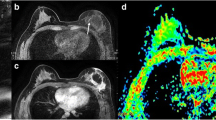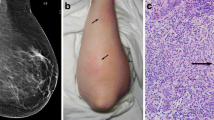Abstract
Purpose
To identify the magnetic resonance imaging (MRI) appearance of idiopathic granulomatous mastitis, and the usefulness of diffusion-weighted magnetic resonance imaging (DW-MRI) in distinguishing idiopathic granulomatous mastitis (IGM) from malignant breast lesions.
Material and methods
A total of 37 women (mean age 36 + 8; range 20–67 years) with histopathologic diagnoses of idiopathic granulomatous mastitis were enrolled in the study. Five patients had bilateral IGM, which were evaluated as ten cases. Dynamic MRI findings were categorized as enhancing mass lesion, non-mass enhancement, or both together. The frequency of quadrant involvement, retroareolar involvement, accompanying abscess, ductal ectasia, skin thickening, breast edema, extension to pectoral muscle, and presence of fistula were investigated. The mean apparent diffusion coefficient (ADC) values for lesions, contralateral normal breast parenchyma, pectoralis major muscle, and sternum were measured in patients with invasive cancers (n = 42) and those with mastitis (n = 42). The ADC ratio of the lesions to the contralateral normal breast parenchyma, pectoralis major muscle, and sternum were determined.
Results
The findings of idiopathic granulomatous mastitis on MRI were total (in all quadrants) or wide (2 or 3 quadrants) in 30 (71.5 %), retroareolar space involvement in 28 (66.7 %), skin thickening in 21 (50 %), breast edema in 21 (50 %), extension to pectoral muscle in 18 (42.9 %), accompanying abscess formation in 33 (78 %), ductal ectasia in 17 (40.5 %), and fistulas in 13 (31 %). On dynamic contrast-enhanced MRI, 69 % of the patients had mass appearance of IGM. The most frequent enhancement patterns were rim enhancement in 20 (78 %) in masses and clustered ring in 11 (48 %) in non-mass lesions. Early enhancement pattern of IGM was obtained as ‘slow’ in 29 cases (69 %), ‘medium’ in 11 cases (26.1) and ‘rapid’ in 2 (5 %) cases. Time-signal intensity curves were detected as Type-1 in 27 cases (64 %) and Type-2 in 15 cases (36 %). IGM showed significantly lower mean ADC values when compared with the normal parenchyma. When IGM was compared with malignancy, mastitis ADC was 0.98 ± 0.188 × 10−3, and invasive cancer ADC was 0.95 ± 0.229 × 10−3. The difference in ADC values of mastitis and invasive cancers proved not to be significant (P = 0.185). Our results had no discriminatory power for IGM versus malignant lesions for either ADC values and ADC ratios of normal breast parenchyma, pectoralis major muscle, and sternum.
Conclusion
Although not characteristic for idiopathic granulomatous mastitis, masses with rim enhancement or clustered-ring non-mass lesions with segmental distribution on MRI are the most common features of the disease. Ductal ectasia and periductal enhancement were commonly accompanying; this and kinetic analysis are valuable findings for distinguishing IGM from invasive cancer. IGM shows similar ADC values to invasive cancers despite being benign, DW-MRI is not helpful in the differentiation with malignant lesions





Similar content being viewed by others
References
Kessler E, Wolloch Y (1972) Granulomatous mastitis: a lesion clinically simulating carcinoma. Am J Clin Pathol 58:642–646
Carmalt HL, Ramsey-Stewart G (1981) Granulomatous mastitis. Med J Aust 1:356–359
Yau FM, Macadam SA, Kuusk U, Nimmo M, Van Laeken N (2010) The surgical management of granulomatous mastitis. Ann Plast Surg 64:9–16
Hovanessian Larsen LJ, Peyvandi B, Klipfel N, Grant E, Iyengar G (2009) Granulomatous lobular mastitis: imaging, diagnosis, and treatment. AJR Am J Roentgenol 193:574–581
Belaabidia B, Essadki O, el Mansouri A, Squalli S (2002) Idiopathic granulomatous mastitis: apropos of 8 cases and review of the literature. Gynecol Obstet Fertil 30:383–389
Ozturk M, Mavili E, Kahriman G et al (2007) Granulomatous mastitis: radiological findings. Acta Radiol 48:150–155
Dursun M, Yilmaz S, Yahyayev A et al (2012) Multimodality imaging features of idiopathic granulomatous mastitis: outcome of 12 years of experience. Radiol Med 117:529–538
Kocaoglu M, Somuncu I, Ors F et al (2004) Imaging findings in idiopathic granulomatous mastitis. A review with emphasis on magnetic resonance imaging. J Comput Assist Tomogr 28:635–641
Yildiz S, Aralasmak A, Kadioglu H et al (2015) Radiologic findings of idiopathic granulomatous mastitis. Med Ultrason 17(39):44
Al-Khawari HA, Al-Manfouhi HA, Madda JP et al (2011) Radiologic features of granulomatous mastitis. Breast J 17:645–650
Woodhams R, Matsunaga K, Iwabuchi K et al (2005) Diffusion-weighted imaging of malignant breast tumors: the usefulness of apparent diffusion coefficient (ADC) value and ADC map for the detection of malignant breast tumors and evaluation of cancer extension. J Comput Assist Tomogr 29:644–649
Woodhams R, Kakita S, Hata H et al (2005) Identification of residual breast carcinoma following neoadjuvant chemotherapy: diffusion-weighted imaging—comparison with contrast-enhanced MR imaging and pathologic findings. J Comput Assist Tomogr 29:644–649
Zhao J, Guan H, Li M, Gu H, Qin J, Wu X (2016) Significance of the ADC ratio in the differential diagnosis of breast lesions. Acta Radiol 57:422–429
Aslan H, Pourbagher A, Colakoglu T (2015) Idiopathic granulomatous mastitis: magnetic resonance imaging findings with diffusion MRI. Acta Radiol. Oct 26
Bani-Hani KE, Yaghan RJ, Matalka II, Shatanawi NJ (2004) Idiopathic granulomatous mastitis: time to avoid unnecessary mastectomies. Breast J 10:318–322
Parra DM, Santos MN, Guerrero BM et al (1997) Utility of fineneedle aspiration in the diagnosis of granulomatous lesion of the breast. Diagn Cytopathol 17(108–114):17
Jorgensen MB, Nielsen DM (1992) Diagnosis and treatment of granulomatous mastitis. Am J Med 93:97–101
Heer R, Shrimankar J, Griffith CD (2003) Granulomatous mastitis can mimic breast cancer on clinical, radiological or cytological examination: a cautionary tale. Breast 12:283–286
Van Ongeval C, Schraepen T, Van Steen A et al (1997) Idiopathic granulomatous mastitis. Eur Radiol 7:1010–1012
Schelfout K, Tjalma WA, Cooremans ID et al (2001) Observations of an idiopathic granulomatous mastitis. Eur J Obstet Gynecol Reprod Biol 97:260–262
Cakir B, Tuncbilek N, Karakas HM et al (2002) Granulomatous mastitis mimicking breast carcinoma. Breast J 8:251–252
Tuncbilek N, Karakas HM, Okten OO (2004) Imaging of granulomatous mastitis: assessment of three cases. Breast 13(510–514):26
Tokunaga E, Kimura Y, Kitamura K, Maehara Y (2004) Granulomatous lobular mastitis misdiagnosed as breast carcinoma. Breast J 10(261–262):27
Breucq C, Verfaillie G, Bourgain C et al (2005) Mastitis granulomatosis. Breast J 11:289–291
Tozaki M, Igarashi T, Fukuda K (2006) Breast MRI using the VIBE sequence: clustered ring enhancement in the differential diagnosis of lesions showing non-masslike enhancement. Am J Roentgenol 187:313–321
Kuhl CK, Mielcareck P, Klaschik S, Leutner C, Wardelmann E, Gieseke J, Schild HH (1999) Dynamic breast MR imaging: are signal intensity time course data useful for differential diagnosis of enhancing lesions? Radiology 211:101–110
Wenkel E, Geppert C, Schulz-Wendtland R et al (2007) Diffusion weighted imaging in breast MRI: comparison of two different pulse sequences. Acad Radiol 14:1077–1083
Yankeelov TE, Lepage M, Chakravarthy A et al (2007) Integration of quantitative DCE-MRI and ADC mapping to monitor treatment response in human breast cancer: initial results. Magn Reson Imaging 25:1–13
Marini C, Iacconi C, Giannelli M et al (2007) Quantitative diffusion-weighted MR imaging in the differential diagnosis of breast lesion. Eur Radiol 17:2646–2655
Kuroki-Suzuki S, Kuroki Y, Nasu K et al (2007) Detecting breast cancer with non-contrast MR imaging: combining diffusion-weighted and STIR imaging. Magn Reson Med 6:21–27
Hatakenaka M, Sodea H, Yabuuchi H et al (2008) Apparent diffusion coefficients of breast tumors: clinical application. Magn Reson Med Sci 7:23–29
Guo Y, Cai YQ, Cai ZL et al (2002) Differentiation of clinically benign and malignant breast lesions using diffusion-weighted imaging. J Magn Reson Imaging 16:172–178
Author information
Authors and Affiliations
Corresponding author
Ethics declarations
Ethical approval
This article does not contain any studies with animals performed by any of the authors. All procedures performed in studies involving human participants were in accordance with the ethical standards of the institutional and/or national research committee and with the 1964 Helsinki declaration and its later amendments or comparable ethical standards.
Informed consent
Informed consent was obtained from all individual participants included in the study.
Conflict of interest
The authors declare that they have no conflict of interest.
Rights and permissions
About this article
Cite this article
Yilmaz, R., Demir, A.A., Kaplan, A. et al. Magnetic resonance imaging features of idiopathic granulomatous mastitis: is there any contribution of diffusion-weighted imaging in the differential diagnosis?. Radiol med 121, 857–866 (2016). https://doi.org/10.1007/s11547-016-0666-x
Received:
Accepted:
Published:
Issue Date:
DOI: https://doi.org/10.1007/s11547-016-0666-x




